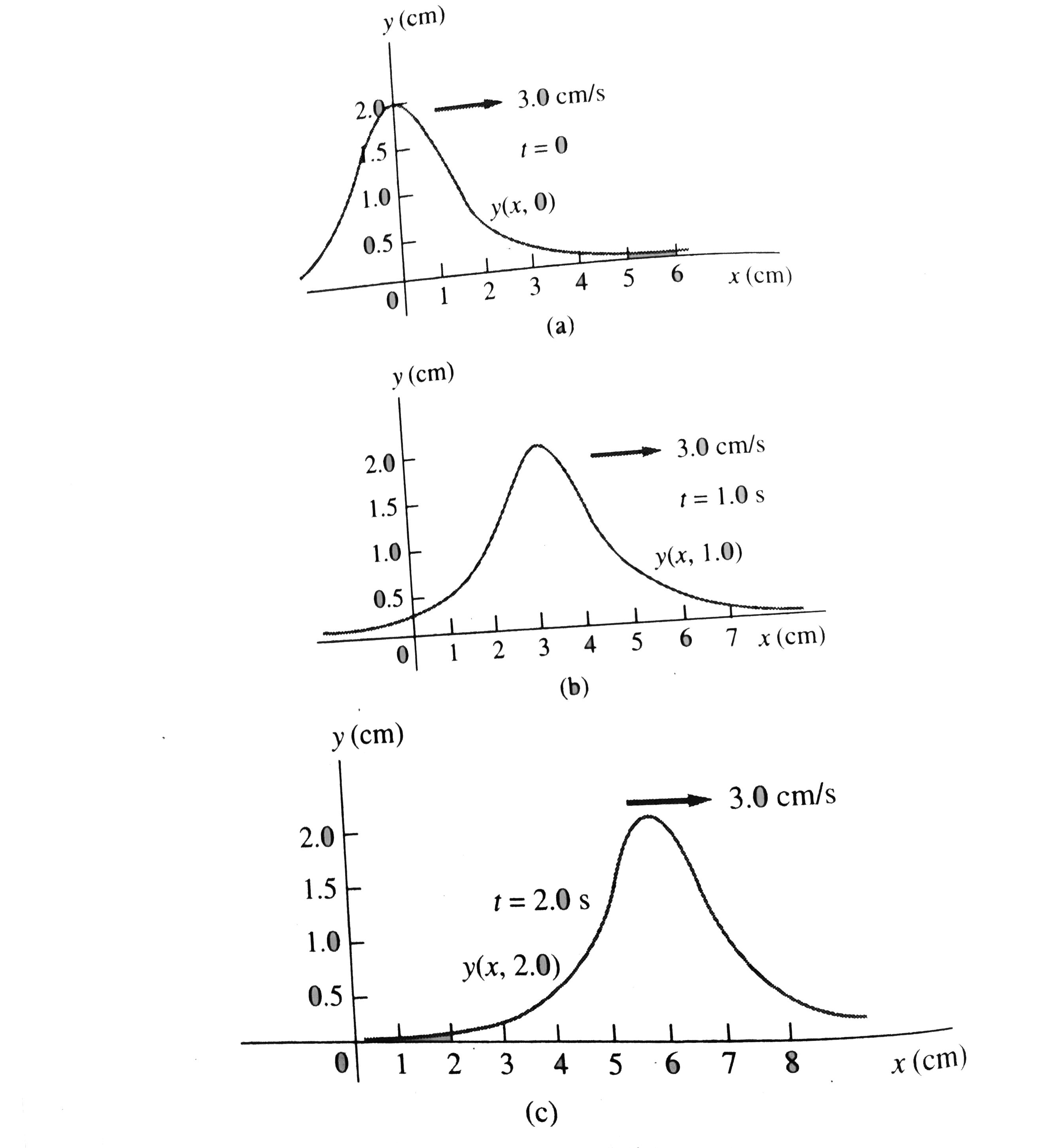A pulse moving to the right along the x-axis is represented by the wave function
where x and y are measured in cedntimetres and t is measured in seconds. Find expression for the wave function at t=0,t=1.0s,andt=2.0s and plote the shape of pulse at these lines.
shows the pulse represented by this wave function at t=0. imagine this pulse moving to the right and maintaining its shape as suggested by (b) and (c ).

we categorize this example as a relatively simple analysis problem in which we interpret the mathmatical representation of a pulse.
The wave function is of the form y=f(x−vt). Inspection of the expression for y(x,t) reveals that the wave speed is v=3.0cm/sFurthermore, by letting x−3.0t=0, we find that the maximum value of y given byA=2.0cm.
write the wave function expression at t=0:
y(x,0)=2x2+1
write the wave function expression at t=2.0s:
y(x,1.0)=2(x−3.0)2+1)
write the wave function expression at t=2.0s:
y(x,2.0)=2(X−6.0)2+1
for each of these expressions we can have various values of x and plot the wave function. this procedure yields the wave function shown in the three parts of ,
these snapshots show that the pulses move to the right without changing its shape and that it has a constant speed of 3.0cm/s.
What if the wave function were
y(x,t)=4(x+3.0t)2+1)
How would that change the situation?
Answer: One new feature in this expression is the puls sign in the denominator rather than the minus sign. The new expression represents a pulse with the same shape as that in the previous figure, but moving to the left as time progress. Another new feature here is the numerator 4 rather than 2. Therefore, the new expression represents a pulse with twice the height of that in figure.
Topper's Solved these Questions
- BOOK - CENGAGE PHYSICSCHAPTER - TRAVELLING WAVESEXERCISE - Example9videos
TRAVELLING WAVES
- BOOK - CENGAGE PHYSICSCHAPTER - TRAVELLING WAVESEXERCISE - Exercise 5.19videos
TRAVELLING WAVES
- BOOK - CENGAGE PHYSICSCHAPTER - TRANSMISSION OF HEATEXERCISE - Single correct9videos
TRANSMISSION OF HEAT
- BOOK - CENGAGE PHYSICSCHAPTER - VECTORSEXERCISE - Exercise Multiple Correct5videos
VECTORS
Similar Questions
A wave pulse moving along the x axis is represented by the wave funcation
y(x,t)=2(x−3t)2+1
where x and y are measured in cm and t is in seconds.
(i) in which direction is the wave moving ?
(ii) Find speed of the wave.
(iii) Plot the waveform at t=0,t=2s.View SolutionA particle moves along the positive branch of the curve with x governed by where x and y are measured in meters and t in seconds. At t = 2s, the velocity of the particle is
View Solution
Knowledge Check
- Question 1 - Select One
A wave is represented by the equation, y=0.1sin(60t+2x), where x and y are in metres and t is in seconds. This represents a wave
Atravelling with a speed of 130 m/s, in the negative x directionBtravelling with a speed of 30 m/s, in the positive x directionCof wavelength 30π metreDof frequency (30π) hertz - Question 2 - Select One
A transverse wave propagating along x-axis is represented by y(x,t)=8.0sin(0.5π−4πt−π/4) where x is in metres and t is in seconds. The speed of the wave is
A8 m/sB4π m/sC0.5π m/sDπ/4 m/s. - Question 3 - Select One
A wave is represented by y=0.4cos(8t−x2) where x and y are in metres and t in seconds. The frequency of the wave is
A4πs−1B8πs−1C5πs−1D6πs−1
A transverse wave propagating along x-axis is represented by: y(x,t)=8.0sin(0.5πx−4πt−π4) Where x is in metres and t is in seconds. The speed of the wave is:
View SolutionA transverse wave propagating along x-axis is represented by: y(x,t)=8.0sin(0.5πx−4πt−π4) Where x is in metres and t is in seconds. The speed of the wave is:
View SolutionA particle moves along positive branch of the curve, y=x2,wherex=t33, x and y are measured in meters and t in seconds, then
View SolutionA plane wave is represented by
x=1.2sin(314t+12.56y)
Where x and y are distances measured along in x and y direction in meters and t is time in seconds. This wave hasView SolutionA standing wave is represented by, y−Asin(100t)cos(0.01x), where x,y and A are in millimeter and t in second. The velocity of the wave is
View Solution

